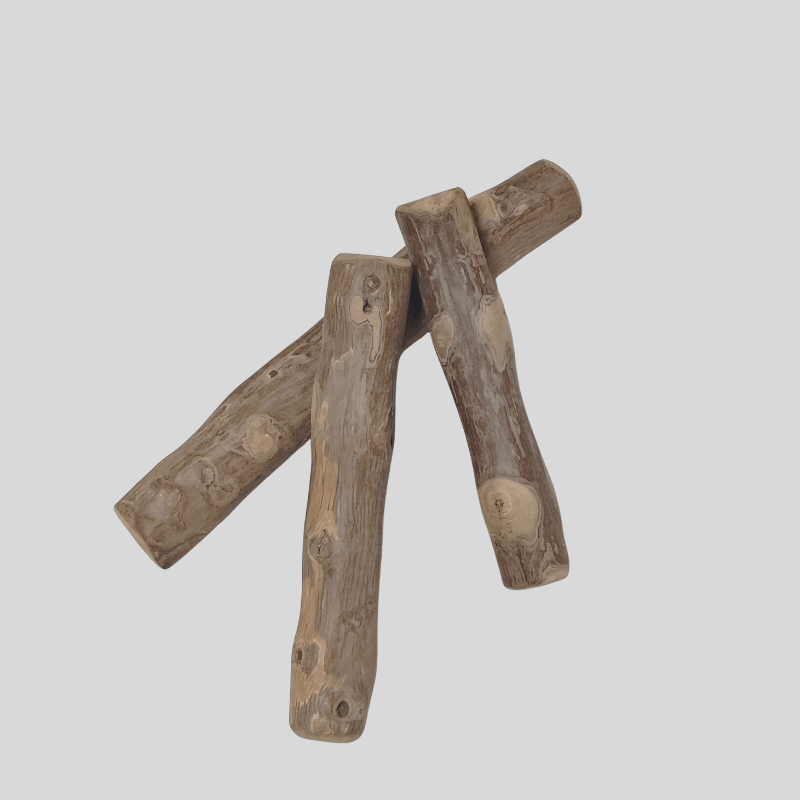When you walk into your living room and find your favorite shoes shredded, the couch edges mangled, or baseboards chewed down to splinters—panic sets in. 😱
Your dog was perfectly fine yesterday, but today? It’s like they’ve turned into a furry little woodchipper.
Sudden destructive chewing is actually quite common—and often totally fixable. Let’s uncover what might be driving this behavior, and how natural tools like coffee wood chews can help.
Don’t Panic: It’s Not Out of Spite!
Your dog isn’t chewing your things for revenge. Chewing is an instinctive, deeply rooted behavior. It’s their way of expressing an unmet need or reacting to change. Think of it like a toddler throwing a tantrum—there’s always a reason.
The Most Common Causes of Sudden Destructive Chewing
1. Teething in Puppies (3 to 8 Months Old)
What’s happening: Adult teeth are pushing through sore gums, and chewing helps relieve the discomfort.
Clues: Focused chewing on soft things like shoes or furniture, whining, drooling, or finding tiny baby teeth.
How coffee wood helps: Its dense, textured surface offers satisfying pressure on sore gums. It’s more durable than plush toys, offering long-lasting relief.
2. Boredom or Lack of Stimulation
What’s happening: Your dog is understimulated—mentally and physically. Chewing fills the boredom gap.
Clues: Chewing on multiple objects, restlessness, barking, or pacing.
Why coffee wood works: It requires focus and effort, turning a 30–60 minute chew session into a mental + physical workout.
3. Anxiety or Stress
What’s happening: Chewing releases endorphins that calm the dog. Stressors like separation, loud noises, or sudden changes can trigger this behavior.
Clues: Chewed door frames or windows, destruction when you’re away, panting, whining, or potty accidents.
Coffee wood’s role: Acts as a calming activity. Give it before a stressful moment (like leaving the house). While not a cure, it’s a great tool in your dog’s anxiety toolkit.
4. Hunger or Inadequate Feeding
What’s happening: Your dog might not be eating enough, or often enough. Chewing mimics foraging behavior.
Clues: Chewing on non-food items, constant scavenging, or sudden food obsession.
How coffee wood helps: It’s non-edible, but chewing satisfies the behavioral urge between meals.
5. Unmet Instinctual Drives
What’s happening: Some breeds (like Labs, Huskies, and Terriers) are born chewers. Without a “job,” their energy becomes destructive.
Clues: Ongoing chewing of doors, furniture—even as adults.
Why coffee wood helps: It satisfies powerful chewing instincts in a healthy way. 💪
6. Medical Issues
What’s happening: Mouth pain, GI problems, or neurological issues could drive obsessive chewing.
Clues: Bleeding gums, vomiting, sudden behavior changes.
What to do: Always check with your vet first before offering chew toys. Rule out health issues before assuming it’s behavioral.

4PACK-Coffee Stick For Dogs
Turning Chaos into Calm: Your Action Plan 🛠️
✅ 1. Vet Check First
Rule out any medical problems before making behavior changes.
✅ 2. Identify the Trigger
Observe when and what your dog chews. Patterns can reveal the underlying cause.
✅ 3. Protect the Environment
Use crates, baby gates, or deterrent sprays to limit access when unsupervised.
✅ 4. Meet Basic Needs
- Exercise: Daily walks, play sessions
- Mental stimulation: Training games, puzzles, scent work
- Routine: Predictability helps reduce stress
✅ 5. Offer Safe, Structured Chewing Time
- Supervised coffee wood chew sessions (30–60 mins)
- Use at regular times—like your coffee break or bedtime
- Rotate with other durable chew toys
✅ 6. Address Anxiety Proactively
- Consult a trainer or vet for chronic anxiety
- Use chews as part of a calming routine
✅ 7. Be Patient and Consistent
Changing habits takes time. Stay steady and positive.
Chewing = Communication, Not “Bad Behavior”
If your dog suddenly starts chewing, it’s not sabotage—it’s a signal. Figure out why, meet the need, and redirect. With the right support (hello, coffee wood chews!), you can turn destruction into a healthy, relaxing habit.
